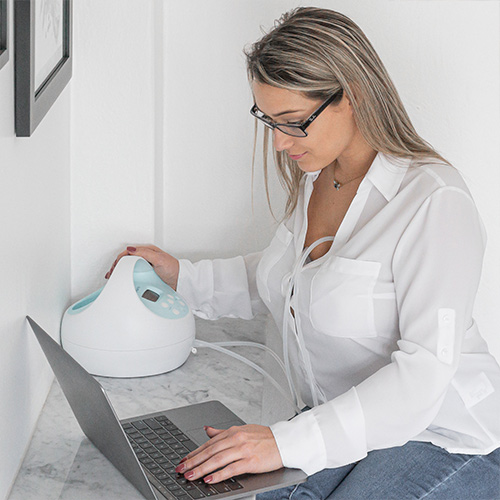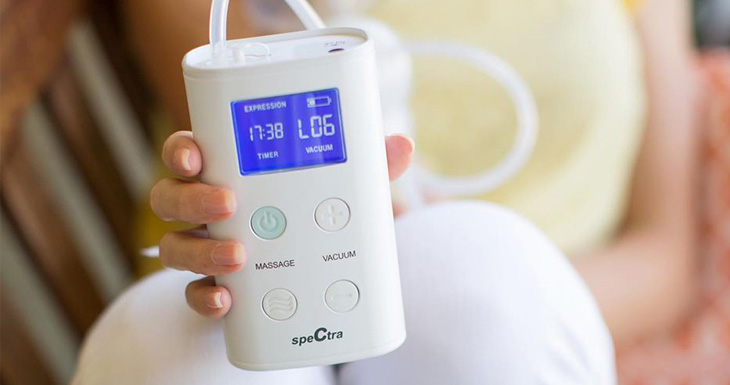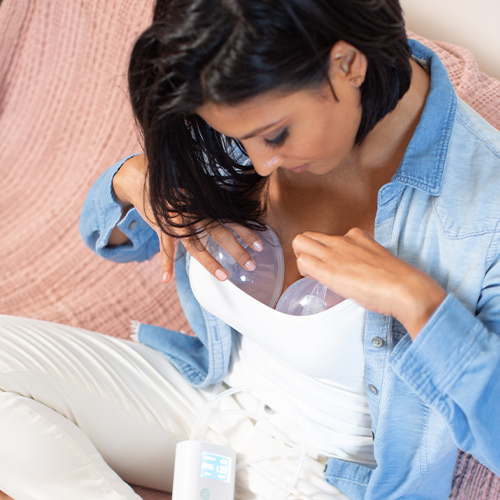Melissa Portunato MPH, IBCLC, RLC
The first few weeks after your baby finally arrives is the time to soak in those yummy newborn snuggles. You shouldn’t have to worry about pumping just yet. But when you are ready, you might pump for reasons like going back to work, a weekend get-a-away, low milk supply, special circumstances with baby, or simply “my nipples just really need a break.” It’s best to wait until 4 to 6 weeks postpartum to start pumping. However, pumping can be a lifesaver when you want a freezer stash of milk for returning to work or important “mommy time” away from baby! Depending on your personal needs, you might need to pump occasionally or around the clock. Regardless of your reasons, one thing is for sure: pumping will allow your baby to continue receiving all those valuable immunological benefits that breast milk provides.
Below are 5 facts to help you get started with your Spectra breast pump!
1.Choosing the right breast pump and flange size
There are a few basic types of pumps: manual pumps, battery-operated pumps, and electrical pumps. Each of these pumps extracts milk by providing a seal around your nipple and areola while it applies and releases suction as baby would do at the breast. Suction strength and cycle speed will vary depending on the type of breast pump and whether you are single pumping (one breast) or double pumping (both breasts at once). If you are returning to work or exclusively pumping, a double electric breast pump will yield the best results. You can learn more about finding the perfect Spectra Baby USA hospital strength breast pump here.
Finding the right size flange is an important part of the pumping process. A flange that doesn’t fit properly could leave you with nipple pain, redness, and full breasts. Yikes! No worries, it’s easy to measure your nipples using this breast shield guide that you can print out. This will save you time and stress with wondering whether or not you have the correct flange fit.
2. When should I start pumping?
If baby is growing well and has unlimited access to the breast, there is no need to start pumping right away. Pumping can add another layer to your busy day, and if breastfeeding is going well, no need to hook up the pump just yet. Waiting 6-8 weeks is best. You could even start sooner if you are returning to work around 4 weeks after birth, but keep in mind the very early weeks are for establishing your milk supply, bonding and nursing, not pumping. These guidelines are for healthy full-term infants. There are instances where pumping will be necessary right from the start, like with preterm infants or when medical conditions have been presented.
Start with pumping once a day at first and then gradually increase sessions according to your breastfeeding goals. Starting with a pumping session about 30 min after an early morning nursing session is a great time! If you are returning to work, you will have plenty of time to build a nice freezer stash for when you are away. Moms are often surprised at how much milk they can store in just a few short weeks!
3. Now, Let’s Get Pumping!
Wash your hands with warm soapy water, gather your pump and accessories, and find a comfy place to relax. Don’t watch the collection bottles slowly fill up drop by drop! Instead, watch a video of your baby or listen to music! This can help you feel more at ease and allow your milk to start flowing freely. Research shows moms can yield about double the amount of milk when stimulating their breasts while pumping. Using a hands-free bra will allow for easier “Hands on Pumping.” Massaging and compressing your breasts while expressing will help you get the most out of your pumping session. It’s recommended to pump for a total of 15-20 min.
Try these settings:
Massage 70
Expression 54
Massage 70
Expression 38
*Vacuum should always be set to comfort, 5 min on each setting.
4. How much milk should I be pumping?
The newborn belly is super tiny. Studies show exclusively breastfed babies from 1 to 6 months old will consume an average of 25 ounces per day. Depending on if you are pumping for a missed feeding or pumping in between feedings, you can expect to pump roughly 1.5 – 4 ounces. At first, when your production is ramping up, expect to pump less milk. It takes time and practice to get your body to respond to the pump, just like when you were learning to breastfeed.
5. Clean. Store. Prepare.
The CDC recommends sterilizing all your pump parts for the very first time before initial use. There is no need to sterilize the tubing since it will never contact your milk or pump! Have a designated bin to wash your pump accessories after each use in warm soapy water and then air dry on a clean dish or paper towel. Using non-antibacterial soap is ideal to ensure you aren’t leaving any film on the flanges that can inhibit the natural secretion of your Montgomery glands on your areola.
Keep your liquid gold safe for baby by adhering to the CDC guidelines for storing and preparing expressed breast milk.
Between breastfeeding, changing diapers, building baby gear, and managing all the visitors wanting to get a glimpse of your fresh bundle of joy (but seriously have a plan in place on handling visitors), you will have a full plate. Pumping really doesn’t have to be an additional item on your to-do list. During those sacred early weeks, concentrate on skin-to-skin and directly feeding your baby at the breast as much as possible.
Have more questions on how to get started with your Spectra Baby USA breast pump? Schedule a complimentary consultation with us here.
We’re here for you and we support you!







